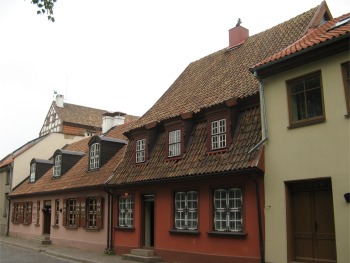 18th Century Buildings |
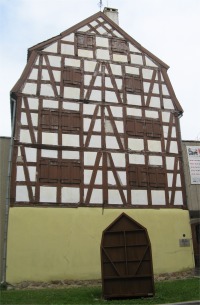 Fachwerk Warehouse |
The Polish chap was leaving at 7am, so after a hasty nap, we arose to allow him to unhitch himself. However, a more officious harbour master had turned up, telling us in no uncertain terms that this marina and the one adjacent were for the use of locals only (obviously policy had changed since the guide book was last published). He stipulated that we would have to move and moor up the Dane River with other "guests". We hastily made our way there and got ourselves sorted out. Yet another harbour master was on the case for this berthing area. The quay was quite high; fortunately this harbour master supplied ladders for crew to gain access to the top of the quay.
 Meridianas |
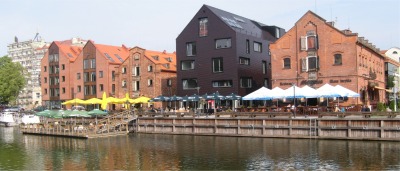 Restaurants by the Dane River |
As we progressed around the Old Town, we came upon a peppering of modern and Soviet functional buildings, indiscriminately scattered around the primarily cobbled streets. The city could be forgiven for not having a cohesive building arrangement in the tourist area, due to the ravages of the history it had endured. The old "showpiece" buildings did seem to be in a state of neglect; obviously recognised for their importance, but perhaps not having the funding to restore them to their original condition.
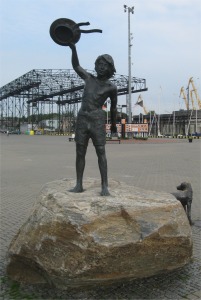 "A Childhood Dream" |
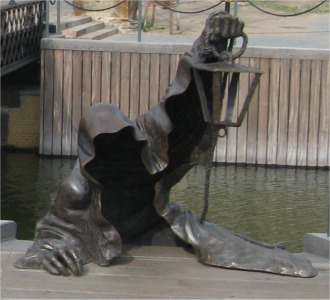 "Black Ghost" |
 "Four Winds" |
 The Arch |
Later, I had a wander further afield. Where the Dane River merged into the Kursiu Marios, a statue stood, "A Childhood Dream". It featured a little boy waving his hat, accompanied by his dog, greeting ships entering the port, and bidding a fond farewell to those leaving. By the swingbridge to the Castle Museum marina, a statue of "The Black Ghost" climbed through the embankment, holding a lantern. The legend has it that in 1595, one of Klaipeda's castle guards saw a ghost, who warned the city that it might face a shortage of grain and timber.
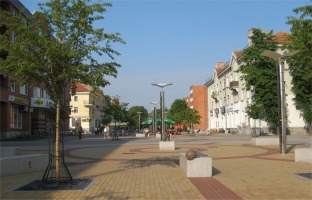 New Town Street |
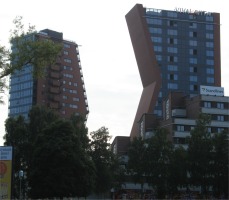 Interesting Concept |
I strolled by the riverside. Here, as in other Baltic states, groups of young women were gathered, excitably chatting as they took photos of each other in model type poses. They tittered nervously when they noticed people spotting them. My walk took me through a more modern part of the city, with broad streets, some cobbled, with many chic shops lining them. Despite the neglect of the Old Town, here wealth in the city was reflected in this more affluent quarter. A feeling of busyness pervaded the area, and yet again, eye contact was hard to establish.
To wind up the evening, Alan and I had a pleasant meal in one of the riverside restaurants, served by young staff who spoke very good English, and then we retired to a jazz club to listen to some live modern jazz played by competent musicians.
15th June
When I arose, Alan informed me that he had been up in the night sorting out the fenders. A squall had got up and was throwing the boat against the quayside, which had been poorly designed from a berthing stance. I had slept soundly through all the commotion.
Alan was busy planning our next leg of the journey, which involved all sorts of parameters such as Polish and Lithuanian Naval exercises, as well as wind speed and direction, the latter two proving to be highly unpredictable.
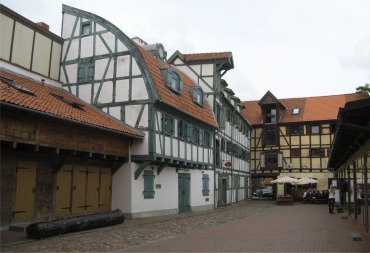 Cultural Communications Centre |
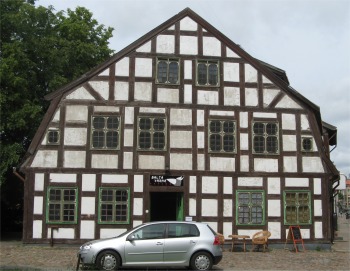 Half Timbered Building |
Now that I knew where to make provisions for our next sea journey, I hiked to the Museum of Minor Lithuanian History. I wasn't sure what "minor" referred to here. A group of Germans were assembled around the ticket office, and gradually dispersed to allow me to purchase my ticket. "Nach oben", snapped the woman at the counter, nodding to a flight of stairs. Why she should presume I was German I'll never know; perhaps most visitors were German. I climbed the stairs and entered a room full of photographs and exhibits showing Klaipeda in the throes of World War II. The text was all in Lithuanian and German, and my knowledge of the latter helped me get the gist of it. In a nearby room, I came across some photographs of Lithuanian Minors, with nothing to explain what they were. Somewhat perplexed, I asked the attendant, who said she spoke a little German but no English. She took me to an office, hoping the young woman inside could deal with my enquiry. The girl understood English, but sadly could not explain to me what the Minors were, so she went off to find someone else.
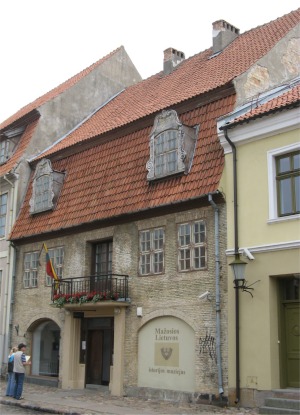 Museum of Minor Lithuanian History |
I asked her how folk felt after the Russians left in 1991. She understood that many old people felt it would have been better if they had stayed; there was always guaranteed work under Russian rule. However she and her parents were glad to have the oppression lifted, and valued the ability to talk freely again. Many Russians remained, and as in Latvia, often in positions of power. She saw the remaining Russians having an attitude problem, whereby it was accepted practice to pilfer from the companies they worked for and from the state. She was appalled by this, and stated that corruption was rife.
The young woman knew of many who had left the country to seek a better way of life abroad, indeed 25% of her final year at school had gone abroad. Many young folk in the country were gaining high qualifications, only to find themselves sweeping the streets or working in cafes. After the initial euphoria of independence in 1991, many people were disappointed that there was still no real investment in the country for it to progress.
I thanked her profusely for her assistance and frank disclosures, and complimented her on her English. She left me to explore the rest of the museum, which was highly informative for those who could read Lithuanian, covering the history of the town and the Minor people from the 11th century to the present day, but sadly I could not interpret all the text.
On my way back to the boat I visited the castle museum. All that was left of the original castle was a partial moat with earth battlements inside, and a couple of tunnels in the bastions. The tunnels housed accounts of the castle through the ages, with various artifacts, plus history of the area and the harbour. Sadly the films showing life under the Soviets, as recommended by the girl in the Lithuanian Minor museum, were not on display. I was the only visitor, and the staff were not pulling out any stops for me.
I arrived back at the boat to find Alan in a panic. Choppy water in the Kursiu Marios was feeding up the Dane River, and the boat was getting smashed into the quay causing damage. We immediately shifted the vessel further up the river, despite protestations from the harbour master. During the move, we met up with an English couple who were sailing anti-clockwise around the Baltic. During the off-season, they took their boat out of the water on Fehmarn Island off the north German coast. There, local farmers provided each boat with its own trailer, and stored all the boats in huge warehouses, and all the shifting of the craft could be pre-arranged via a phone call. Moreover, it came at a third of the price that they would be charged in England.
In the evening we visited a different part of the city which contained an alley brimming with outside restaurants. By chance, it also had a live group playing there too, primarily jazz, but a few Eric Clapton songs were thrown in too; bliss. I was also enthralled by a jazzed up rendition of Scott Joplin's "Entertainer".
